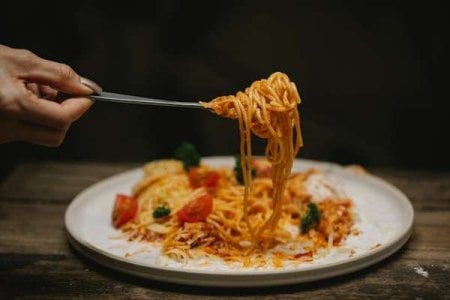This top chef's secret will change the way you eat pasta forever!
By
Danielle F.
- Replies 11
As Australians, we've embraced a multitude of international cuisines, and Italian dishes have found a special place in our hearts and on our dinner tables. But what if I told you that a classic pasta dish, one that's become a staple in many of our homes, might be getting a bit lost in translation? It's time to rethink how we've been serving up spaghetti bolognese, according to a top Sydney chef.
Alessandro Pavoni, an Italian-born culinary maestro who has trained in Michelin-starred kitchens, has a bone to pick with the way we've been dishing out this beloved meal. The chef, who has been tantalising Sydney's taste buds since 2003 and is the mastermind behind the acclaimed fine-dining Italian restaurant a'Mare at Crown Sydney, says we're not doing justice to the traditional Italian way of enjoying pasta.
The issue at hand? It's all about the pasta shape. Pavoni points out that around the world, people are pairing chunky sauces like bolognese with the wrong type of pasta, such as thin or smooth varieties. 'People love using thin or smooth pasta with chunky sauces — like Bolognese on capellini or pesto on penne,' he said in an interview. 'It just doesn’t work — the sauce slides off or gets lost. You need the right shape to catch the sauce properly.'

In Italy, the classic bolognese sauce is traditionally served with tagliatelle verdi, a fresh pasta that incorporates spinach for a vibrant green colour. These wide ribbons are designed to cradle the hearty meat sauce, ensuring each forkful is perfectly balanced. Meanwhile, spaghetti, which many of us have been using for bolognese, is actually meant for lighter fare, such as a delicate vongole with clams and garlic.
But the pasta shape isn't the only pitfall we're encountering in our kitchens. Pavoni highlights other common mistakes, including drowning pasta in too much sauce, overcooking it past the point of al dente, and skipping the crucial step of tossing the pasta in the pan with the sauce. To achieve that authentic Italian taste, pasta should be coated, not swimming, in sauce and finished with a splash of pasta water to bring all the flavours together.
For those looking to master the art of pasta at home, Pavoni offers some sage advice: salt your water generously, use a big pot to give the pasta room to move, and never rinse your pasta after cooking. 'Always finish it in the sauce—that’s where the magic happens,' he insists. 'And don’t overthink it. Keep it simple, respect the process, and the pasta will speak for itself.'
Even a top chef like Pavoni isn't above reevaluating his choices. He recently made a switch in the pasta shape for the iconic pesto dish at a'Mare, moving from trofie, a short, twisted pasta, to trottole, a thick twirl that scoops more sauce and adds texture. This change has been a hit with customers, who relish the fresh pesto made table-side, offering a sensory experience that's both aromatic and visually stunning.

So, dear members of the Seniors Discount Club, next time you're boiling water for pasta, remember Pavoni's pearls of wisdom. Choose the right pasta shape for your sauce, aim for al dente, and let the pasta finish cooking in the sauce for a truly Italian experience. It's a simple change that could revolutionise your pasta nights, turning a familiar dish into something extraordinary. Share your pasta successes (and any secret tips of your own) in the comments below – we'd love to hear how you're bringing a taste of Italy into your kitchen!
Alessandro Pavoni, an Italian-born culinary maestro who has trained in Michelin-starred kitchens, has a bone to pick with the way we've been dishing out this beloved meal. The chef, who has been tantalising Sydney's taste buds since 2003 and is the mastermind behind the acclaimed fine-dining Italian restaurant a'Mare at Crown Sydney, says we're not doing justice to the traditional Italian way of enjoying pasta.
The issue at hand? It's all about the pasta shape. Pavoni points out that around the world, people are pairing chunky sauces like bolognese with the wrong type of pasta, such as thin or smooth varieties. 'People love using thin or smooth pasta with chunky sauces — like Bolognese on capellini or pesto on penne,' he said in an interview. 'It just doesn’t work — the sauce slides off or gets lost. You need the right shape to catch the sauce properly.'

Spaghetti Bolognese is a popular pasta dish seen in countless restaurant and cafe menus. Image Credit: Pexels/Klaus Nielsen
In Italy, the classic bolognese sauce is traditionally served with tagliatelle verdi, a fresh pasta that incorporates spinach for a vibrant green colour. These wide ribbons are designed to cradle the hearty meat sauce, ensuring each forkful is perfectly balanced. Meanwhile, spaghetti, which many of us have been using for bolognese, is actually meant for lighter fare, such as a delicate vongole with clams and garlic.
But the pasta shape isn't the only pitfall we're encountering in our kitchens. Pavoni highlights other common mistakes, including drowning pasta in too much sauce, overcooking it past the point of al dente, and skipping the crucial step of tossing the pasta in the pan with the sauce. To achieve that authentic Italian taste, pasta should be coated, not swimming, in sauce and finished with a splash of pasta water to bring all the flavours together.
For those looking to master the art of pasta at home, Pavoni offers some sage advice: salt your water generously, use a big pot to give the pasta room to move, and never rinse your pasta after cooking. 'Always finish it in the sauce—that’s where the magic happens,' he insists. 'And don’t overthink it. Keep it simple, respect the process, and the pasta will speak for itself.'
Even a top chef like Pavoni isn't above reevaluating his choices. He recently made a switch in the pasta shape for the iconic pesto dish at a'Mare, moving from trofie, a short, twisted pasta, to trottole, a thick twirl that scoops more sauce and adds texture. This change has been a hit with customers, who relish the fresh pesto made table-side, offering a sensory experience that's both aromatic and visually stunning.
Key Takeaways
- Top Sydney chef Alessandro Pavoni claims that Australians are eating spaghetti bolognese incorrectly by pairing the sauce with the wrong type of pasta.
- The correct way to serve Bolognese, according to Pavoni, is with tagliatelle verdi – wide green ribbons that can carry the meat sauce perfectly.
- Pavoni offers key tips for perfecting pasta, advising against overcooking, using too much sauce, and highlighting the importance of the final toss in the sauce with pasta water.
- The chef also shared insights into his own learning process at a’Mare, changing the pasta shape for the pesto dish to trottole for better sauce coverage and an enhanced dining experience.







